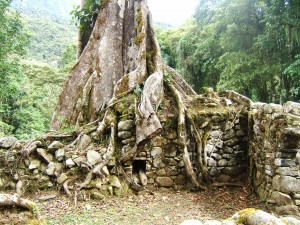.
.
Ten years ago I sat in the middle of the ruins of Espíritu Pampa and despaired that it would ever be cleared. Dense jungle covered the site. Kapok trees had ripped open the Inca stonework, their roots gripping doorways and niches. Brush obscured the lines of the great Plaza, the kallankas and the ornamental fountains.
.
The work of ever restoring the place seemed both Herculean and pointless – the ruins were too extensive and remote, the vegetation just too dense, for this, unlike most Inca sites, had been built not in the mountains, but in the jungle on the eastern slopes of the Andes as they joined the Amazon.
The site has enormous emotional resonance – ‘the last bastion of Inca resistance’, as a noticeboard proclaims at its entrance, it saw the final dying of the flame after the Spanish conquest in 1532. Having held out in the mountains of the Vilcabamba for some 40 years, by 1572 the last Emperor, the young Tupac Amaru, was on the run, pursued down here into the rainforest by a Viceroy intent on finally wiping out “the pretender across the mountains”.
Espíritu Pampa was burnt in the process; the Emperor caught and executed.
But perhaps because it is such a potent symbol, the Peruvian government have made a superhuman effort and cleared it – one substantial section just three weeks before we arrived. I can finally appreciate the immense size of the site, radiating out from the central Plaza where they have tactfully left a few of the giant kapok trees.
Now is the time to visit, before the vegetation returns under a less benign or interested administration; or when someone realises that with just 30 or so visitors a year making the week long journey, the cost of maintaining it cannot be justified.


I agree with all of that. It was a delightful surprise to see that so much had been cleared, and sympathetically so that one can appreciate the structure of the buildings while also being very aware of the effects of more than four centuries as the jungle has reclaimed the site. The Peruvian authorities deserve great credit for the work that has been done. Maybe, once the new bridge at Azul Mayo is completed, more visitors will come (though not too many, I hope!)and it will be considered worthwhile to maintain the site in its present state and even investigate further. For me, the heaps of Spanish roof tiles in situ were the most exciting things to see.
Amazing place I have read so much about! Would love to get there and to some of the lesser known and visited sites.
I have just returned from a 2 week holiday in Peru, the second week of which was an extended trek to Machu Picchu. Your books were a great inspiration to me throughout my time there, and reading your blogs like this one I realise there is so much more I want and need to see in this beautiful country.
I have written a day by day account of my stay in my own blog, and if you are interested in reading it, then it all starts here
http://www.starjump.org/jamesa/?p=187